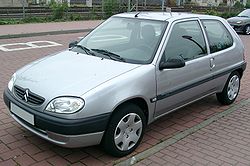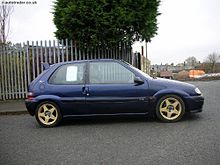- Citroën Saxo
-
Citroën Saxo 
Saxo 1st Generation Saxo 2nd Generation
Saxo 2nd GenerationManufacturer Citroën Also called Citroën Chanson Production 1996-2003 Assembly Aulnay-sous-Bois, France, Predecessor Citroën AX Successor Citroën C2
Citroën C3Class Supermini Body style 3-door hatchback
5-door hatchbackLayout FF layout Engine 1.0 L TU9 I4
1.1 L TU1 I4
1.4 L TU3 I4
1.5 L TUD5 diesel I4
1.6 L TU5 I4Wheelbase 2,385 mm (93.9 in) Length 3,718 mm (146.4 in) (3,737 mm (147.1 in) VTS) Width 1,595 mm (62.8 in) (1,620 mm (63.8 in) VTS) Height 1,379 mm (54.3 in) Curb weight 805 kg (1,775 lb)–935 kg (2,061 lb) Related Peugeot 106  Saxo 1.5D MkI
Saxo 1.5D MkI
 Saxo VTR MkII
Saxo VTR MkII
The Citroën Saxo is a supermini produced by the French manufacturer Citroën (PSA) from 1996 to 2003. It was also sold in Japan as the Citroën Chanson. It shares many engine and body parts with the Peugeot 106 (which itself was a development of the Citroën AX), the major difference being interiors and body panels. It was replaced by the Citroën C2 in the autumn of 2003.
Contents
Engines and performance
All engines were from the PSA TU engine series that powered the Peugeot 205 from 1988 and the Citroën AX, and had their roots before that with the OHC PSA X engine various other PSA cars used, such as the Citroën Visa, Peugeot 104 and early Peugeot 205. The range included five petrol engines and one diesel engine, all naturally aspirated.
Although the power outputs seem low in modern terms, even the range-topping VTS had a kerb weight of just 965 kg (2,127 lb), giving all models quite a 'nippy' feel around town.
The 1.0 was quite underpowered, the 1.1 was much better, since it was nearly 200 cc larger, and had roughly 30% more torque.
There were 3 sport models of the Saxo:
- The Westcoast, later replaced by the Furio which featured a 1.4I 8V 55 kW (75PS/75BHP) engine with a top speed of 175 km/h (109 mph), and a 0-62.5 mph (0–100 km/h) time of 11.2 seconds.
- The VTR MK1 (1997–1999) featured a 1.6I 8V 66 kW (90PS/89BHP) engine with a top speed of 187 km/h (116 mph) and a 0-62.5 mph (0–100 km/h) time of 10.0 seconds. The VTR MK2 (1999–2003) featured a 1.6I 8V 72 kW (98PS/97BHP) engine with a top speed of 193 km/h (120 mph) and a 0-62.5 mph (0–100 km/h) time of 9.4 seconds.
- The VTS 16V featured a 1.6I 88 kW (120PS/118BHP) engine with a top speed of 205 km/h (127 mph), and a 0-60 mph time of 7.8 seconds. The VTS MK1 (1997–1999) and MK2 (1999–2003) shared the same performance.
These models included 247 mm (9.7 in) vented front brake discs, with the VTR and VTS also having rear brake discs (solid 247 mm (9.7 in) discs). Also, a different style of control arms and struts was used for the suspension. The VTS had a 22 mm (0.9 in) master brake cylinder, and the VTR and Westcoast/Furio had a 19 mm (0.7 in). The VTS had a 19 mm (0.7 in) front anti-roll bar and 22 mm (0.9 in) rear anti-roll bar, while the VTR and Westcoast/Furio had a 19 mm (0.7 in) front and 21 mm (0.8 in) or sometimes 19 mm (0.7 in) rear anti-roll bar.
In addition, all the sports models featured a different bodykit to the other models, commonly known as the "VT" bodykit.
In 1997 the Saxo's 3 Speed Automatic Gearbox was combined with the 1.6i 8V 88 kW (90PS/89BHP) engine which was available on the Saxo SX and VSX. Then, in late 1997, the 1.6i automatic was replaced with a 1.4i 55 kW (75PS/74BHP) engine. The 1.6i was more powerful with a top speed of 176 km/h (109MPH) compared with the 1.4's top speed of 103 mph (166 km/h).
Citroën carried on using the 1.4i engine on the Facelift Saxo Automatic in 1999. Due to the C3 having a 1.4i Automatic Gear Box the Saxo Automatic came to an end in March 2002, whilst the manual models were still sold right up to the end of 2003.
Interior and equipment
The equipment list was generally sparse, with budget models having drivers air bag, seat belt pre-tensioners, cassette player, heated rear screen and tinted windows, and early mk1's with keypad immobilisers and a clock in place of a tachometer and 3 stud wheels, much like the AX. Further up the list sunroofs, PAS, Electric windows, ultrasonic alarm, passenger airbag, CD player, tachometer, front fog lights, bodykits, colour coded mirror caps and alloy wheels were added, to name a few.
The 1.6L VTR and VTS Saxo's were the best equipped, with both gaining rear disc brakes as opposed to drum brakes, and ABS as standard for the VTS and an optional extra on all other 1.6L models.
Few special models were released throughout the Saxo's life, most notably the "Open Scandal", a Saxo with a full length sliding canvas roof. Other special editions added certain extra's to the lower end model, such as sunroofs or PAS. Notable models are the Westcoast up to 1999 and the Furio to 2003, as they incorporated the standard Saxo bodykit found on the VTR and VTS with a more insurance friendly 1.4L engine.
Air-conditioning was never an option on right-hand-drive Saxo's because the blower motor was mounted in the bulk-head on the drivers side. As a result, there was insufficient space available to accommodate the evaporator, except by first ducting the air flow to the passenger side and then at the expense of the glove-box. Although an after-market kit was available that did exactly this, the resultant pressure loss made the system noisy and ineffective. The blower motor could also not be easily relocated, since the windscreen wiper motor was mounted in the passenger side space.
As with many other small cars of the time, the standard stereo system included 5.25" drivers mounted low in the front doors and 4" drivers mounted in the rear quarter panels (5 door models had 5.25" drivers all round) This set-up could be easily improved upon by mounting separate tweeters in the A-panel trims, similar to many VW models of the time. The very thin door cards and metalwork did however leave the system very 'thin' sounding, with very poor output in the upper-bass ranges.
Facelift
The Saxo received a style makeover at the start of the year 2000, commonly branded as a MK2, with the major differences being more modern styled headlights, bonnets and grilles to replace the square style on the MK1 and Multipoint injection replacing the single point on the 1.1L engines.
PAS became standard on all but the very basic models. More subtle changes were alterations to the rear lights (the indicator sections are more "white") and the engine control unit moved from a single plug to 3 plugs. The old 3 stud wheel layout was also dropped.
There was also a minor facelift during the MK1 phase of the cars production in line with the then current releases by Citroen, moving towards a rounder look.
By 2003, some buyers were more attracted to the spacious and practical five-door C3. However, the 1.6 VTR and VTS models remained popular. The Saxo finally finished production in late 2003 when the three-door C2 was launched. Its twin, the Peugeot 106, also ceased production at this time. By the end of the Saxo's production life it's design was 7 years old.
It was a sufferer of poor performances along with its twin, the 106 in a 2000 EuroNCAP test.
Limited Edition
There were never any limited edition Saxo's ever made by Citroën.
There were 30 'special' models of the Saxo VTS that were made by an independent company in Morecambe,Lancashire called LAD Motorsport. This included 10 San Remo models and 20 Tour De Corse models.
The Tour De Corse models were built in 1997 and had a choice of championship white paint with white alloy wheels or dark blue paint with gold alloy wheels with a rear spoiler.
The San Remo models were built in 1998 and came in championship white paint with white alloy wheels only with a rear spoiler.
All of the ‘special’ models were only available on the mark1 version of the Saxo. LAD Motorsport claimed that all of the 'special' models had a power output of between 160 - 180bhp and could do 0-62mph (0-100km/h) in around 6.24 - 6.37seconds, this was without any forced induction such as a turbo/supercharger and LAD Motorsport claimed it was from ‘minor headwork’. All power claims and figures were proven to be wrong by over 30 different companies throughout the United Kingdom over a number of years and as a result (of the false figures) LAD Motorsport closed down in 2008.
There are many individuals that believe the gold colour and two-tone paint on some VTR and VTS models were a limited edition, Citroën declined this and suggested it was nonesense.
Drag
The Saxo has a drag coefficient of 0.340.[1] In addition its frontal area is 1.83m2.[1] Giving it a CdA ft² just 6.68.
References
- ^ a b "Citroën Saxo 1.1i X technical specifications - Carfolio.com car specifications pages". Carfolio.com. http://www.carfolio.com/specifications/models/car/?car=78155. Retrieved 2011-08-07.
« previous — Automobiles Citroën, a subsidiary of the PSA Peugeot Citroën since 1976, car timeline, 1980s–present Type 1980s 1990s 2000s 2010s 0 1 2 3 4 5 6 7 8 9 0 1 2 3 4 5 6 7 8 9 0 1 2 3 4 5 6 7 8 9 0 1 Economy car 2CV Off-roader Méhari City car C1 Supermini LN / LNA AX Dyane Axel Saxo I Saxo II C2 DS3 Visa C3 I C3 II Small family car GSA ZX Xsara I Xsara II C4 I C4 II DS4 Large family car BX Xantia C5 I C5 II DS5 Executive car CX XM C6 Leisure
activity vehicleAcadiane C15 Nemo Berlingo Berlingo II Compact
MPVXsara Picasso C3 Picasso C4 Picasso Large MPV Evasion/Synergie C8 C4 Grand Picasso Crossover C-Crosser Convertible C3 Pluriel Van H Van C25 Jumpy I Jumpy II C35 Jumper Jumper II Categories:- Citroën vehicles
- Subcompact cars
- Euro NCAP superminis
- Front wheel drive vehicles
- Hatchbacks
- Hot Hatch
- 1990s automobiles
- 2000s automobiles
- Vehicles introduced in 1996
Wikimedia Foundation. 2010.


